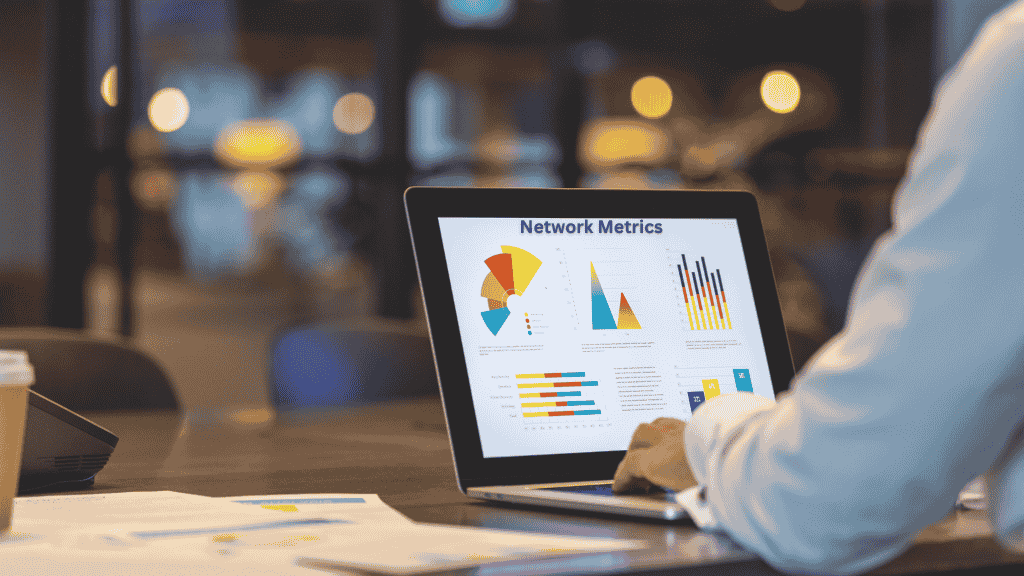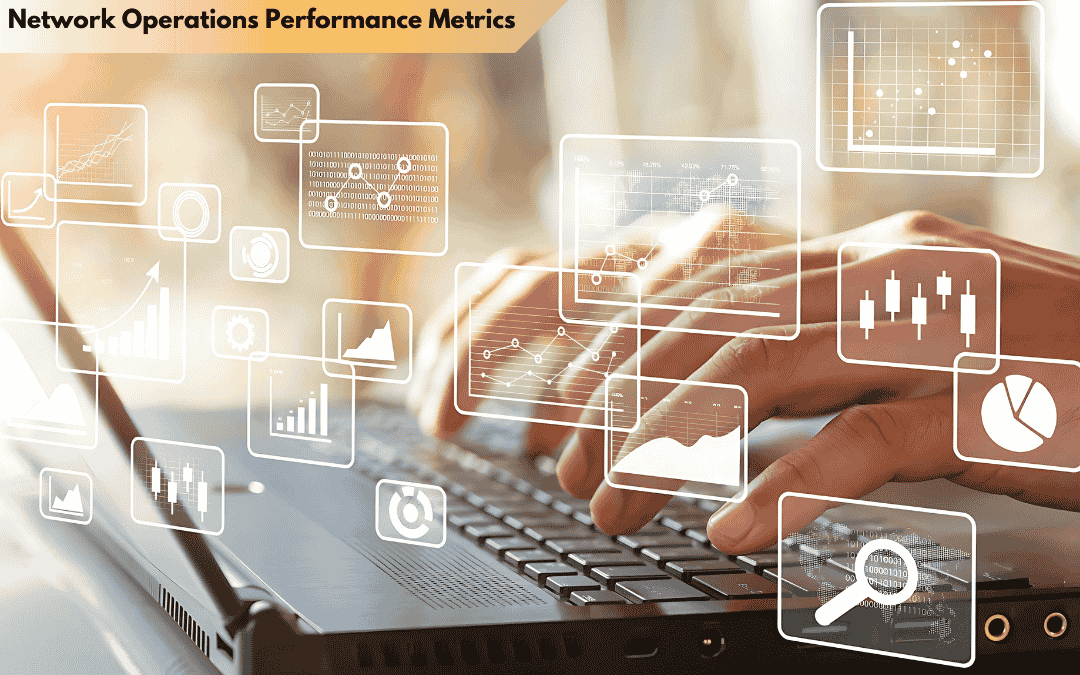Mastering network operations performance metrics is essential for ensuring optimal network performance and reliability. Whether you’re an IT professional or a network engineer, understanding key KPIs & metrics such as bandwidth, latency, and packet loss is crucial.
This blog provides a set of practice questions designed to enhance your knowledge and skills, helping you analyze and optimize network operations effectively. Get ready to dive deep into real-world scenarios and improve your expertise in network performance.
1. What is Network Monitoring?
Network Monitoring involves collecting, analyzing and interpreting data to assess the health and performance of a computer network. The aim of network monitoring is to identify and resolve issues before they can disrupt network operations.
Network Monitoring tools can track numerous network parameters, including latency, packet loss, jitter, bandwidth usage, and other key performance indicators (KPIs). These software tools can generate alerts when issues arise within the parameters being measured, which enables network managers to respond quickly to rectify issues before they escalate.
A variety of technologies are available for network monitoring, such as hardware-based monitoring appliances, software-based solutions that operate on a server or network device, and cloud-based monitoring services. These technologies give network managers a thorough understanding of network performance and assist them in anticipating and resolving possible problems before they become serious.
All things considered, network monitoring is essential to keeping a computer network strong and effective and to guaranteeing that network users have access to dependable and high performing network services.
2. What are Network Metrics?

Network metrics are numerical measurements that are used to assess and track a computer network’s reliability and performance. These measurements, which include speed, bandwidth usage, latency, packet loss, jitter, and other network key performance indicators (KPIs), offer important insights into a variety of features that describe the behaviour, performance and reliability of a network.
Network administrators can diagnose problems, identify performance bottlenecks, and optimize network parameters to increase uptime, enhance user experience, and improve network performance by tracking and evaluating various network indicators.
3. What is Network Performance?
Network performance refers to the evaluation of computer networks ability to deliver quality of service. It involves analysing network statistics and metrics to measure how well it meets the needs of end users.
There are three important concepts in that definition:
- Network Analysis and Review: The first step is to monitor important network performance & its key metrics to establish a historical view of the data. This will allow you to establish baselines based on past performance and allow you to examine and contrast data from network performance measurements over time.
- Assessing Network Performance: Network performance which is directly related to the quality of the network is dependent on a number of factors. For example, the location where measurements are taken influence the results. For instance, a link between Montreal and New York will perform differently to a link between Montreal and Tokyo.
Additionally, the time at which the measurements are taken will affect the outcomes, as network performance typically fluctuates throughout the day. These factors of time and location impact network performance and can result in poor and excellent performance.
- The End User Experience: When evaluating network performance, enhancing end user experience is the most crucial component. However, subjective reports are not enough! The right network monitoring tools allow us to quantify the user experience, and provide measurable data that can be used to improve performance.
4. How to Measure Network Performance

To accurately track network performance from the end user’s perspective, we must conduct tests from their perspective. This involves network performance monitoring from the end user’s location, without requiring the installation of a network monitoring tool on each user’s workstation. Furthermore, recording every data packet for analysis is not recommended, as this can raise privacy concerns and require significant hardware resources.
- Step 1: Deploy Network Performance Monitoring Software
- Step 2: Deploy Monitoring Agents
- Step 3: Measure Network Metrics
5. What does Latency Mean in Networking?
Network latency refers to the delay in data transfer across a network. It measures how long it takes for data to move from its source to its destination across the network. Networks with minimal delays have low latency, those with a prolonged delay or lag have high latency.
Businesses prefer low latency and faster network speed to increase productivity and streamline operations. Certain applications, such as fluid dynamics and high performance computing require low network latency to function effectively. High network latency results in degradation of performance.
6. Which Metric is most Commonly Used to Measure the Capacity of a Network?
Network bandwidth is representative of the maximum of a wired or wireless communication link to transfer data over a network connection within a specified time frame. It is usually expressed by bits, kilobits, megabits, or gigabits per second. Bandwidth is used interchangeably with data transfer rate and capacity. However, bandwidth is not a measure of network speed.
7. What does “Packet Loss” Indicate about Network Performance?
Packet loss is commonly noticed by users when there are disrupted Voice over Internet Protocol (VoIP) calls, a stalled video, or delayed downloads. Typically, it results in decreased connection speeds and throughput of the network.
Latency refers to delays in data transfer, which is different to packet loss, which is the failure of the data to reach its destination.
Each application handles latency differently. For example, delays in document downloads do not have large negative impacts on end users. However, voice calls or video that are impacted by latency will have a much greater impact on user experience.
8. What is the Primary Function of a Network’s Quality of Service (QoS) Mechanism?
QoS enables an organization to prioritize resources and network traffic to ensure that specific applications or services perform at a desired level. It empowers companies to prioritize different applications, data flows, and users to optimise network performance.
9. What is TCP/IP Protocol Suite?

TCP/IP or the Internet Protocol Suite, is a set of networking protocols that work together to enable the transfer of data packets between computers across a network. The two fundamental protocols are Transmission Control Protocol (TCP) and Internet Protocol (IP).
The core component of TCP/IP is addressing and routing network packets between computer systems, which is defined by the Internet Protocol. Consider an IP as clearly defined road networks that connect various cities. TCP, a connection-oriented protocol, then acts as the reliable parcel delivery service, ensuring the guaranteed delivery of data packets between cities.
Many of the regular protocols we use today, such as HTTP, SMTP (email), and SSH, are developed on top of the TCP protocol because it guarantees packet delivery.
10. Does the Solution provide Comprehensive End-to-End Visibility?
In the current digital environment, network management solutions need to process data from several sources, such as routers, firewalls, switches and more. This allows IT infrastructure management teams to gather the necessary metrics to measure and provide a high-performance digital experience.
Additionally, the ability to alert teams of network and application performance issues results in proactive troubleshooting and fast resolution.
11. Is Cloud Monitoring Supported?

The definition of “cloud” might mean different things to different organizations, it is essential that the Network Performance Monitoring solution can comprehensively monitor all aspects of your network and the underlying infrastructure.
This encompasses SaaS and corporate applications hosted in private, public and hybrid cloud environments. It’s crucial to ascertain up front whether the NPM solution can offer the end-to-end visibility you need to remove the blind spots that often arise when applications are migrated to the cloud.
12. Does the Solution provide Comprehensive Application Monitoring and Optimization?
Optimized application performance monitoring is essential to a business’s productivity and profitability. However, in today’s distributed world core business operations are often dispersed across several service and application providers, so optimization is challenging. Legacy Network Performance Monitoring systems often lack the end to end visibility needed to monitor these complex distributed systems.
Managing complex modern applications requires the Network Monitoring Solution to address these three critical components: application visibility, network optimization, and application performance evaluation.
All applications are reliant on the underlying network infrastructure; therefore, application performance must be analyzed in conjunction with network performance and network infrastructure metrics. Only when an application is built on a strong network and an efficient NPM solution can you provide insights into both aspects.
Conclusion
In conclusion, Analyzing network performance metrics is vital for optimizing network efficiency and minimizing issues. By regularly practicing with relevant questions, you can strengthen your understanding of crucial metrics and improve your problem-solving skills. The insights gained from these exercises will empower you to proactively manage network performance, ensuring seamless operations. Continue practicing, stay updated with evolving technologies, and enhance your ability to tackle network challenges effectively.

